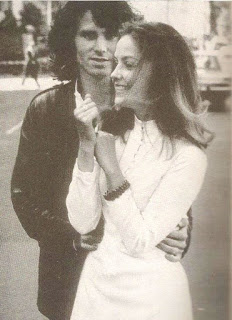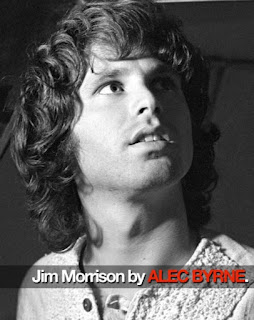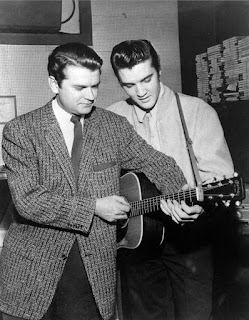Jim Morrison "Desolation Row" video — Soundtrack: "Desolation Row" by Bob Dylan (from his album Highway 61 Revisited, 1965) and "Love me Two Times" by The Doors (from their second studio album Strange Days, 1967), sung by Jim Morrison. The lyrics of "Love me Two Times" (Love me two times, I'm goin' away) were about a soldier on his last day with his girlfriend before shipping out to war (Vietnam).
Skull Island has made the decision to set its action in the very closing days of the Vietnam war, and in the aftermath of Richard Nixon’s 1973 televised speech ending US involvement in the country. Brie Larson plays anti-war photojournalist Mason Weaver. Bill Randa (John Goodman), a member of the shadowy Monarch organisation, attempts to exploit the soldiers still stationed overseas - specifically a unit led by Colonel Packard (Samuel L. Jackson) - to act as escort to his expeditionary team, including Mason Weaver and Tom Hiddleston’s ex-SAS man. An undiscovered island has emerged in the advent of satellite imagery, shrouded in a perpetual storm and wrapped in several centuries of myth. Everyone who crosses paths here immediately greets each other with the synopsis take on their personal feelings towards American actions in Vietnam; as Packard tells an anti-war Mason, “the camera’s way more dangerous than the gun… we didn’t lose the war, we abandoned it”. “Sometimes an enemy doesn’t appear until you create one,” is uttered at one point. You get it? Kind of like in Vietnam? Source: www.independent.co.uk
“Kong: Skull Island” is more consistent and well-developed in its pursuit of the idea that the obsessive American quest for victory in Vietnam can only lead to disaster. Packard’s decision that he will kill Kong as a way of proving American valor and beating the Vietnamese by proxy ultimately leads him into serious strategic miscalculations and moral errors. In a nice moment that undercuts action hero tropes, Cole (Shea Whigham) tries to sacrifice himself to save his fellow soldiers: His efforts end up rather dramatically for naught. And Randa, who was willing to bomb another country and another people to prove his intellectual theories, meets an appropriately grisly end. Source: www.washingtonpost.com
Francis Ford Coppola’s 1979 film Apocalypse Now begins with “The End” and ends with it, too. A smattering of lyrics along the way seem to capture the nightmare atmosphere of the American War in Vietnam. “It just started out as a simple goodbye song,” James Douglas Morrison told reporter Jerry Hopkins. “Probably just to a girl, but I could see how it could be goodbye to a kind of childhood...” Morrison's father, George Morrison, commanded the U.S. Naval fleet during the August 1964 Gulf of Tonkin incident, an event that precipitated an escalation of the American War in Vietnam. Forged in the fading afterglow of World War II, America’s plans to save a backward people were elaborate indeed. To Washington, the Vietnamese seemed to be “Desperately in need of some stranger’s hand In a desperate land...” America’s moral superiority, its ingenuity, its technological know-how, were unstoppable; the fall of those Southeast Asian dominos would be arrested, and communism would be stopped. The lyrics of The End presaged: “It hurts to set you free, But you’ll never follow me, The end of laughter and soft lies, The end of nights we tried to die.”
America’s grand plans later revealed themselves to be bankrupt. Bombing millions into slums and refugee camps didn’t necessarily mean those people would follow you. Soft lies mouthed by the military at 5 p.m. each evening were no substitute for actual victories. Laughter and glad-handing and talk of easy triumph were repeatedly blown apart. By the time it was all over, by the time the end had come, the entire American effort had hemorrhaged and bled out in a million hamlets across South Vietnam. Jim Morrison recorded “The End” in 1966, when the American project in Vietnam still had life in it. Unlike his father, who passed away in 2008, he never saw the end of the Vietnam War. He died in France — the country whose war in Vietnam the Americans had bankrolled and then taken over — in 1971. In a 1969 interview, Jim Morrison said that he was once approached by an attractive young woman “on leave” from UCLA’s Neuropsychiatric Institute. She said “The End” was a favorite of the kids in her ward. Source: www.huffingtonpost.com
Jim Morrison: "I think that for any generation to assert itself, it has to break with the past, so obviously the kids that are coming along next are going to create their own unique sound [punk, grunge]. Things like wars and monetary cycles get involved, too. Rock and roll probably could be explained by... it was after the Korean War was ended... and there was a psychic purge. There seemed to be a need for an underground explosion, like an eruption. So maybe after the Vietnam War is over — it'll probably take a couple of years maybe; it's hard to say — but it's possible that the deaths will end and there will again be a need for a life force to express itself, to assert itself." —Interview by Jerry Hopkins (Rolling Stone magazine, July 26, 1969)
While Jim Morrison rejected the type of radical political freedom associated with mass politics and the New Left, his focus on personal politics mirrored the consciousness-raising methods pioneered by second-wave feminism. The band took an unequivocal stance against the Vietnam War. The 1968 song “The Unknown Soldier” uses the war to address the core themes of fear and personal liberation. The song begins with a subdued tone; Morrison takes the role of a narrator oppressed by the conflict. After the eponymous Unknown Soldier is “executed” in a dramatic martial interlude: “Make a grave for the unknown soldier / Nestled in your hollow shoulder,” the dramatic confrontation with fear and pain—the death of the “unknown”—leads the listener to a climax of ecstatic release. While the Doors took a stance against the Vietnam War and in favor of personal liberation, Morrison was critical of some of the more “revolutionary” modes of sixties political activism and was deeply ambivalent about politics, focused more on personal expression. Source: quod.lib.umich.edu
Jim Morrison: "I think that for any generation to assert itself, it has to break with the past, so obviously the kids that are coming along next are going to create their own unique sound [punk, grunge]. Things like wars and monetary cycles get involved, too. Rock and roll probably could be explained by... it was after the Korean War was ended... and there was a psychic purge. There seemed to be a need for an underground explosion, like an eruption. So maybe after the Vietnam War is over — it'll probably take a couple of years maybe; it's hard to say — but it's possible that the deaths will end and there will again be a need for a life force to express itself, to assert itself." —Interview by Jerry Hopkins (Rolling Stone magazine, July 26, 1969)
Being in bed with Jim was like being in bed with Michelangelo’s David, only with blue eyes. He knew in his worst blackouts to put my diaphragm in and take my contact lenses out. His skin was so white, his muscles were so pure, he was so innocent. He used to suggest, “Let’s go to Ships and eat blueberry pancakes with blueberry syrup.“ My friend Judy Raphael, who went to film school, remembers Jim as this pudgy guy with a marine haircut who worked in the library at UCLA. Like everyone back then, Jim hated his parents, hated home, hated it all. If he could have gotten away with it, Jim would have been an orphan. Jim, who’d lost thirty pounds in one summer (the summer of ’65, from taking drugs instead of eating, and hanging out on the Venice boardwalk), tried lying about not having parents, creating his life anew. My sister Mirandi never thought Jim was that cute, but then my sister was one of Pamela’s friends, and it was in her best interest to ignore Jim, even though, for a month, my sister and her boyfriend lived with Jim and Pamela, and it was almost impossible. “He was always a very dark presence in a room,” Mirandi said, “I’d say it was of a person who was severely depressed. Clinically depressed.” And she's a psychologist.
Pamela looked sunny and sweet and cute – she had freckles and red hair and the greenest eyes and just the country girl glow. So it was hard to believe her purse was stuffed with Thorazine. She wore mauve eyeshadow, soft expensive suede boots, and large shawls. My sister Mirandi and Pamela had to fight to persuade Jim to leave his hair long, because left to his own devices he’d get it cut preppy-short and break everyone’s heart. Pamela had control over Jim in real life. And he made his audiences suffer for that. The night I was in the bungalow of Ahmet Ertegun, it was February 9, 1971, the night of the Apollo 14 moon landing commanded by Alan Shepard.
Jim was guzzling Scotch and looking sullen, but he carefully took in Ahmet Ertegun's gossip about the Rolling Stones, now signed to his label. Jim rose to his feet and bellowed, “You think you’re going to win, don’t you?! Well, you're not going to win. We’re going to win, us – the artists. Not you capitalist pigs!” You could have heard a pin drop in this roomful of Ahmet’s fashionable upscale friends. Everybody was silent except the moon landing reporter on the TV, until I stood up and heard myself say, “But Ahmet is an artist, Jim!” The people who were there refused to remember what had happened; they shrugged. “You know,” Jim said, staring straight into my eyes, “I’ve always loved you.” It was one of those tricky nights when Ahmet was trying to make up his mind whether he was going to seduce Jim away from Elektra Records. Ahmet had lured Mick Jagger away from his label the year before. The last time I saw Jim with no shirt on, at a party up in Coldwater, his body was so ravaged by scars, toxins and puffy pudginess, that I wanted to kill him. Underneath his mask, Jim was dead. But then, by 1971, who wasn’t? —Eve Babitz for Esquire Magazine, March 1991































































